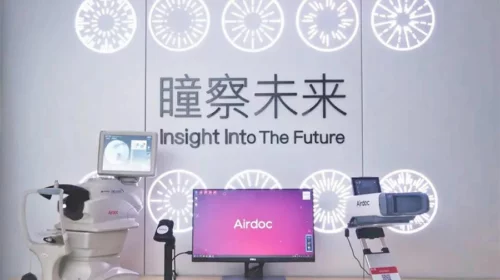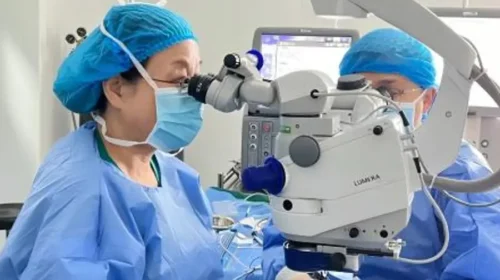So-Young dolls up with pivot to high-end services

The cosmetic services social media platform is developing its own clinics as well as a premium platform for high-end users
Key Takeaways:
- So-Young reported an annual profit last year, reversing two years of losses, as its revenue rose 19%
- The company’s new So-Young Prime service for high-end users helped to fuel a 22.2% revenue jump in its information services segment last year
By Edith Terry
So-Young International Inc.’s (SY.US) latest quarterly results provided a facelift for its tired stock, which jumped 4% in the days after its announcement last week. Still, the small pop left shares of the cosmetic services platform operator well below prettier times when it debuted on the Nasdaq in 2019 at a price 20 times its Wednesday close of $1.08.
The latest results showed that So-Young is charting a new course following a series of setbacks, including greater focus on higher-end customers and a move away from working with smaller cosmetic surgery clinics that have become frequent targets of crackdowns. That helped to lift the company back to profitability last year after losing money in the two previous years.
The stock’s weak post-IPO performance reflects a period that encompassed Covid-19 restrictions when many cosmetic surgery clinics were forced to close or scale back operations and people avoided elective medical procedures to minimize risk of infection. It also included a regulatory crackdown on advertising in the medical aesthetics industry starting in 2021.
The regulatory environment got even harder last year, as medical aesthetics providers were required to get licensed before advertising their services. According to the Chinese Association of Plastics and Aesthetics, only 28% of doctors in the industry are certified practitioners.
Only around 13,000 medical beauty institutions in China are currently licensed, with another 80,000 lacking any qualifications, according to market research firm iResearch. The licensing process is not only strict, but also time consuming, now requiring around nine months, up from three months in the past, according to one industry source.
In announcing its latest results, So-Young CEO Jin Xing acknowledged that last year was “even more challenging” for the company than the situation during the pandemic.
“Looking back on the past year, we believe our differentiated strategy with a focus on premium services and products for high-tier users was – and will continue to be – key to maintaining stable growth going forward,” he added.
Revenue for the fourth quarter increased by 20% to 390.6 million yuan ($55 million) year-on-year, although the company’s net income fell by nearly half. For the full year, its revenue of 1.5 billion yuan represented a 19.1% increase from 2022. And more importantly, its 2022 non-GAAP net loss of 22.2 million yuan in 2022 turned into a profit of 57.6 million yuan last year.
A new $25 million share repurchase and special cash dividend of $0.06 per American depositary share (ADS), announced together with the results, helped to sweeten the pot for holders of So-Young shares. That upbeat news was tempered by the company’s forecast that first-quarter revenue would be up by only a low single-digit amount year-on-year, representing a sharp slowdown from the fourth quarter.
The bigger picture, according to Jin, is that So-Young is going through a “strategic transformation,” which includes a new platform aimed at high-end users. Launched in the third quarter of 2022, So-Young Prime integrates “product, doctor and institutional sources” and is associated with a project to build “light aesthetics” clinics with other partners based on a model clinic operating in So-Young’s headquarters.
Clinic developer
A big part of the 20% increase in So-Young’s total revenue last year came from a 15.8% rise in its information services, one of its three main revenue categories, primarily driven by new revenue from So-Young Prime, according CFO Zhao Hui.
The model clinic in So-Young’s headquarters opened last August and is a template of the kind of facility that the company would like to use for its partnerships with third-party operators. It took only three months to break even, and Jin said So-Young would open more than 10 similar clinics in six cities this year. The company ultimately plans to work with partners on a chain of such clinics, with several under construction and others operational.
For its broader partnership business, So-Young generated over 200,000 visits and 100 million yuan in revenue for its partner clinics last year.
One blemish on So-Young’s report card was a decline in its gross margin from about 68% in 2022 to 64% last year. The company blamed the drop on low margins for So-Young Prime due to its early stages of development, and to growth in medical product and maintenance sales that have lower margins than information services.
Sales of medical products and maintenance services made up 22% of revenue in 2023, at 333.5 million yuan. The company’s biggest money earner is information services, which contributed 1 billion yuan last year. Notably, revenue from the company’s third major source, reservation services, fell more than 20% last year to 101 million yuan. So-Young explained the decrease was due to higher subsidies for end-users.
Understanding the nature of these three revenue sources helps to explain why So-Young needs to change its business model. The company earns reservation service fees when it refers its users to actual clinic operators, which is quite similar to the more heavily regulated medical advertising business.
By moving into medical products, mostly injectables, and building its own chain of clinics, So-Young can look more like a provider of its own direct products and services for its users rather than promoter of such services from other companies.
The company’s evolution towards a more direct provider of cosmetic products and services is still a work in progress. But there’s certainly plenty of money in the booming sector, as younger users, including young men, begin to focus on light aesthetic treatments like Botox and hyaluronic acid injections.
According to research in So-Young’s 2019 prospectus, China’s medical aesthetic services industry was worth 121.7 billion yuan in 2018 and was expected to grow to 360.1 billion yuan by 2023. Of course, that was before Covid, and more recent data from competitor iGengmei says that the market size reached 311.5 billion yuan in 2023, up 20% year-on-year.
So, how does So-Young stack up against its listed competitors? Its price to earnings (P/E) ratio of 21 trails the 38 for Yonghe Medical (2279.HK), a leading provider of hair replacement services. But Hong Kong-based medical beauty center operator Perfect Medical (1830.HK) trades lower at a P/E of just 12.
Is So-Young on the right track? Three of four analysts surveyed by Yahoo Finance seem to think so, rating the company as a “strong buy,” while the fourth rates it a “buy.” Having made it through the pandemic and a regulatory crackdown in relatively good shape, the odds seem to be in So-Young’s favor, at least for now.
To subscribe to Bamboo Works free weekly newsletter, click here






